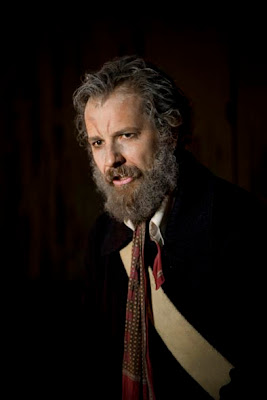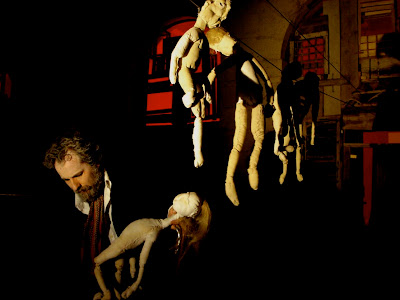Wednesday 19 August 2009
Sunday 16 August 2009
BBC News, 15.08.09
Magical dream on mystery island
| By Angie Brown Edinburgh reporter, BBC Scotland news website |

I am still wondering if maybe I fell down a long and tumbling tunnel after seeing a rabbit at the start of my Fringe adventure to Cotrone's mystery island.
It had looked like it was beckoning me to follow it, before hopping off.
The next thing I knew the bus was pulling up at the Forth Belle ready to board for Inchcolm Island, which lies between Edinburgh and Fife.
Maybe I had dozed off in the bus and the rabbit had just been a dream, I wasn't sure.
Enchanting and soothing music was playing out of the small ferry's loud speakers as I watched seabirds fly alongside and as Edinburgh's coastline merged into one big line I wondered if again I had fallen into a deep slumber.
| Andrea Cusumano The Bitter Belief of Cotrone the Magician |
Cotrone was a mysterious man, I was being told on the loud speaker, a sorcerer who arrived on the uninhabited isle in 1965 and if we looked hard enough we "might see him".
As we neared the craggy outcrop, which was being circled by almost menacing seagulls, I wondered if I wanted to step off from the safety of the boat into this other place.
However, the sight of the island's 12th Century abbey soon brought me to my senses again, and I drifted with the rest of the audience to my straw bale of a seat amid the stone ruins.
Cotrone appeared as if by magic from behind a stone wall, draped in a black cloak, wearing a white mask and shuffled towards us while leaning on his staff.
I prayed this terrifying grey-haired Italian recluse with a mouth-organ and a skeleton inside his cloak would not come too close to me and thankfully, as often happens in a dream, he did not actually quite reach me.
 Small Tommy is one of the strange characters on the island |
At this safe distance I was lulled once again by his most enchanting singing and there was that music again, which had been played on the boat.
A cacophony of strange sounds was coming from the four man live band who were to my left and Cotrone broke in to an eerie whistling tune.
Then, from nowhere, a band of strange creatures began walking in a large circle around us.
Cotrone kept conjuring up more and more bizarre fantasies, a minstrel with a bird cage on his head, a chained-up odd red woollen-haired clown-like character with a feather in his mouth and a naked android-like woman.
I was not scared by these weird creatures as it was more of a Lewis Carroll world of strange and fun characters than anything threatening.
I was in such a surreal landscape, the sky full of gull cries, all against such an imposing backdrop, I had to pinch myself to make sure I was not dreaming.
I asked 49-year-old Bill Findlay, a corporate planning officer from Dundee sitting beside me, about his opinion of the show to make sure I had not imagined it all.
He said: "I found it so moving, but I couldn't say why.
"There was fantastic costume, music and the birds made it, it was as if they were part of the show somehow."
As we walked back to the boat, which was waiting to whisk us back to reality I asked Jan Moore, 76, from Chicago, what she thought she had seen.
"It was fascinating as is the setting, it's an amazing place. It didn't seem to have a plot line but the scenery brought it together."
 Cotrone and the Countess take a bow |
Barbara Bryant, 47, from Boston, Massachusetts, said: "I loved it. It reminded me of Prospero, the magician on his island who could make spirits appear. There were lots of theatre themes, players come, and are they really suffering?"
So when I bumped into Sicilian artist and director Andrea Cusumano, who also plays Cotrone, during the boat ride from the island, I had to ask him about what I had just seen.
He said: "Luigi Pirendello's The Giants of The Mountains, from which the show is based, describes Cotrone's house in a very indefinable way, as if it is between dream and reality.
"We devised things together and took the personality from the characters.
"It is much more important that people enjoy the show than understand dialogue. I don't want to represent reality. I want it to be a theatrical reality.
"I speak between English and Italian as I want to keep that duality so that the public cannot follow the story.
"It is emotional because of the beauty of the island, the humour, the grotesque and the very strong visual costume.
"The decision to do the show on an island was not just a special effect.
"What we were trying to do is immerse the public into a dream as if they had fallen asleep and weren't sure whether or not they had really been on the island and seen the things they had seen."
So, as the bus came to a shuddering halt on Waverley Bridge, I wondered if it really had been all a dream.
I am not sure but one thing I do know is, unlike a dream which is usually forgotten within moments of waking up, I will remember The Bitter Belief of Cotrone the Magician for a long time.
Tuesday 11 August 2009
Monday 10 August 2009
Surely one of the richest, strangest show on the Fringe this year [...] Strange beautiful tableaux [...] haunting live score [...] truly magical moment
Susan Mansfield, The Scotsman
inexcusably incomprehensible […]
The List, Matt Boothman
The cast create gorgeous tableaux (the costumes are breathtaking), and the atmosphere – helped by a tight live band and ever-wailing gulls – is eerily memorable
Alice Jones, The Independent
Friday 31 July 2009
Friday 17 July 2009
Friday 3 July 2009


Journey schedule to Cotrone’s mistery island
Pick up time 17:20 Waverley Bridge
Bus arrival 18:00 Hawes Pier, South Queensferry
Boat departs 18:05
Return
Boat departs 20:05
Boat arrives 20:30 Hawes Pier, South Queensferry
Bus departs 20:35
Bus arrives 21:00 Waverley Bridge
For more information contact
robert@sweet-uk.net or call 020 7404 6411
Written and directed by Andrea Cusumano
Performed by
Assistant director
Alexa Reid
With
Alice Bray and Aimi Gdula
Devised by
Andrea Cusumano, Joseph Fairweather Hole, Fernanda Gavito Soto, Cleo Jay, Eun Young Lee, Dimitra Liakoura, Deborah Striebig, Evangelia Theodorou, Wasurat Unaprom.



The Bitter Belief of Cotrone the Magician
a production Andrea Cusumano-CeSDAS
‘A post-surreal fairytale with puppetry, projections and magic’
The Standard, Vienna
‘A constant conflict between life and form, where life and creation fuse’
Orestiadi, Gibellina, Sicily
‘A visionary reinvention of Pirandello’
RAI3, Italy
A Stunning visionary reinvention of Pirandello fusing puppetry, projections, performance, and live music, set in the most amazing location in Edinburgh. Cruise to Cotrone’s Mystery Island in the Firth of the Forth and be mesmerized by the post-surrealistic theatre fairytale…
The piece generated extensive media attention both in Italy and Austria, where it received recognition on
national television channels “RAI3”, and “ORF” (Austria). The production also received reviews in
major national publications including “Der Standard”, “Kleine Zeitung” and “Repubblica”.
A nomadic site-specific performance, written and directed by UK based multimedia artist Andrea Cusumano
and devised by emerging international artists, which draws inspiration from Luigi Pirendellos’s The Giants
of The Mountains, and was developed through onsite research at Palazzo di Lorenzo, Gibiellina, Sicily. The
dramaturgical structure and aesthetic properties of the performances are constructed organically through
inhabiting the site, and are informed by made and found objects. The creative process extends beyond the
original site, continuing to evolve throughout the duration of the project; reaching, influencing and being
influenced by multiple spaces, narratives and audiences.
CeSDAS (Centre for the experimentation of Space Dramaturgy) and it’s collaborators develop performance
based works that focus on the progressive development of a performance lexicon that fosters the practice
of cross-cultural works, and an aesthetic practice that draws inspiration from multiple disciplines and
redefines the use of new and existing medias within theatre practice.
For more information contact:
Sweet Box Office
W www.sweet-uk.net
Hotline 0870 241 0136
E robert@sweet-uk.net
Andrea Cusumano-CeSDAS
5A Station Parade, Station Road
Sidcup DA15 7DB, UK
M 0044(0)7952 728574
E andreacusumano@hotmail.com

The Bitter Belief of Cotrone the Magician on a mystery island location also sounds unmissable.
This reworking of Pirandello involves a boat ride to a mystery island somewhere in the Fifth of Forth in a literal theatrical journey that, upon arrival, promises puppetry, projections, performance and live music. Certainly, this will be experimental artist Andrea Cusumano's most ambitious piece yet.
Cotrone @ Sweet in the Firth of the Forth
Edinburgh 2009
Fondazione Banco di Sicilia Fondazione Orestiadi
In collaboration with:
Historic Scotland
Italian Cultural Institute Edinburgh
Area10 Project Space, London
PLOT
Cotrone, the magician, is the leader of a group of extravagant people, who decided to avoid contact with society and live in a world of fantasy and freedom within the walls of an abandoned house ‘La Scalogna’.
One day, a company of actors guided by the ‘Countess’ approach the house. First Cotrone and his people try to scare them off. But the more they use tricks to frighten them away, the more they approach the house. Finally Cotrone decides to host the Countess and the company in the house.
What takes place then is a dialogue between Cotrone and the Countess, who represents two different ways of conceiving communication and forms. Theatre is used as a metaphor. Cotrone believes that his dreams, images and fantasies only need is to be imagined and they will magically appear in the safe frame of the Scalogna. The Countess' belief is pointless without a public and she is desperately try to perform her repertoire in a real theatre.
At the end of the play the Countess convinces Cotrone to perform, and Cotrone, still not convinced, offers his help and his own company to her purposes.
They will perform for the ‘Giants of the Mountain’, to an uncanny population, which lives in the mountain above the Scalogna. The show will come to a bitter ending with the giants killing and turning into piece the Countess and the entire company.
Some relevant changes from the original version of the ‘Giants of the Mountain’ have been made in our production. In particular Cotrone is the only speaking character while the ‘Scalognati’ are all just puppets. The ‘Countess’ is a Thai transvestite dancer, and therefore her company has been transformed into an oriental musicians procession.
Pirandello left several notes about the ending of the piece, but he died before being able to include it in the play. His bitter ending should have seen the Giants beating, killing and eating the company. We have decided to use it as part of our dramaturgy, and therefore the Countess will finally perform for the Giants.
THE ISLAND
One of the most relevant elements in the work of CeSDAS is the dramaturgical impact of the space. Originally set in an abandoned Baroque palace in the Sicilian countryside, the ‘Bitter Belief of Cotrone the Magician’ has come across several changes and developments depending on the location where it was performed. Sweet in the Firth of the Forth represents the ideal setting for the piece, for its aura and for the extraordinary similarity to the site depicted in the original text.
Conceptually the piece is contemplating 3 different spaces.
1. The Scalogna, the place of isolation and magic of Cotrone and his people (the island itself)
2. The route of the Countess (a jouney trough the sea)
3. The city of the Giants (the city of Edinburgh?)




